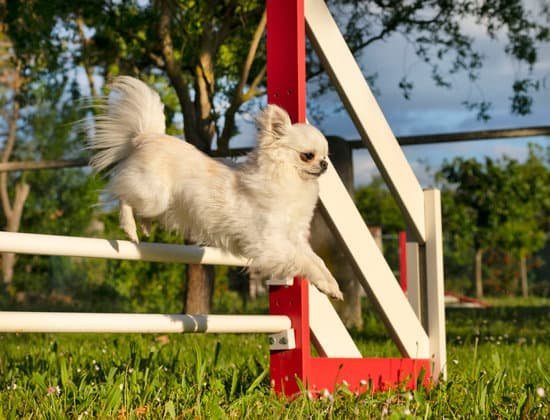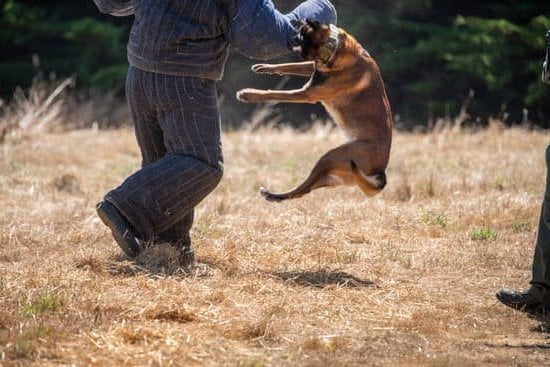Is your dog afraid of strangers? This common issue can make going on walks or having guests over a stressful experience for both you and your furry friend.
However, with the right training techniques and a bit of patience, you can help your dog overcome their fear and build confidence around strangers. In this article, we will explore the psychology behind canine stranger anxiety, how to recognize the signs in your dog, and various training methods that can be used to address this issue.
Understanding the importance of training your dog not to fear strangers is crucial for their overall well-being and quality of life. A fearful dog may become aggressive or anxious in social situations, leading to potential safety risks for themselves, other people, and even other animals. By addressing their fear and teaching them appropriate behaviors, you can provide them with the tools they need to navigate social interactions confidently.
In the next sections, we will delve into the psychology of canine fear and why dogs develop stranger anxiety. We will then discuss how to identify signs of stranger anxiety in your own dog so that you can better understand their behavior.
From there, we will explore various strategies such as building trust and confidence through positive reinforcement training, socialization techniques, counterconditioning methods, desensitization exercises, establishing boundaries, seeking professional help when needed, and ultimately celebrating progress along this journey. So let’s get started on empowering your furry friend to overcome their fears and build confidence when encountering strangers.
The Psychology of Canine Fear
Dogs can develop stranger anxiety for a variety of reasons, which can range from genetic predispositions to negative experiences in their past. Understanding the psychology behind this fear is essential in effectively training your dog to overcome it.
One common reason why dogs develop stranger anxiety is due to a lack of early socialization. If a dog was not exposed to many different people and environments during their critical socialization period, which typically occurs between 3-14 weeks of age, they may be more likely to develop fear or anxiety towards strangers later in life. This lack of exposure can lead to a general fear of the unfamiliar, including new people.
Another factor that contributes to stranger anxiety is negative experiences with strangers in the past. Dogs are incredibly perceptive creatures and they can easily pick up on our emotions and reactions. If a dog had a traumatic experience with a stranger, such as being yelled at or provoked, they may associate all strangers with that negative experience and display fear or aggression towards them.
It’s worth noting that certain breeds may be more prone to developing stranger anxiety due to their genetic predispositions. Some breeds are naturally more cautious or territorial, making them more likely to exhibit fear towards unfamiliar people. However, any dog can potentially develop stranger anxiety regardless of breed, so it’s important not to generalize based on breed alone.
Understanding why dogs develop stranger anxiety allows us to approach their training in a targeted and effective manner. By providing positive experiences and gradually exposing them to different people and situations, we can help build their confidence and trust over time.
| Reasons for Canine Fear | Description |
|---|---|
| Lack of early socialization | Dogs who weren’t exposed to many different people during their critical socialization period may be more likely to develop fear or anxiety towards strangers later in life |
| Negative experiences with strangers | If a dog had a traumatic experience with a stranger in the past, they may associate all strangers with that negative experience and display fear or aggression towards them. |
| Genetic predispositions | Certain breeds may be more prone to developing stranger anxiety due to their genetic predispositions, although it can occur in any breed. |
Recognizing the Signs of Stranger Anxiety in Your Dog
It is essential for dog owners to be able to recognize the signs of stranger anxiety in their dogs in order to address and modify their behavior effectively. Dogs with stranger anxiety may display a variety of behaviors, both physical and emotional, that indicate discomfort or fear around unfamiliar people. By being attentive and observant, you can identify these behaviors and take appropriate steps towards helping your dog overcome their fear.
One common sign of stranger anxiety is excessive barking or growling when someone new enters the vicinity. This can be accompanied by raised fur, a tense body posture, and even showing teeth as a warning sign. Some dogs may also attempt to hide behind objects, cower, or try to escape when encountering strangers. It is important to note that each dog may exhibit different behaviors based on their unique personality and past experiences.
Another noticeable behavior is a change in body language. A fearful dog might have a lowered tail that tucks between their legs or drooping ears. Their body may become stiff, and they may avoid eye contact with strangers by turning away or looking down. Dogs with stranger anxiety might also display submissive behaviors such as urinating or defecating indoors when encountering unfamiliar individuals.
By recognizing these signs, you can start implementing strategies tailored to your dog’s specific needs. The first step is understanding that this fear is not something they can control on their own but rather an emotional response born out of past experiences or lack thereof. With patience, consistency, and proper training techniques, you can help your dog overcome their fear and build confidence around strangers.
Building Trust and Confidence
Building trust and confidence is an essential step in training your dog to not fear strangers. Without a strong foundation of trust, your dog may struggle to feel safe and secure in social situations. Here are some key strategies to help establish a strong foundation for training.
Firstly, it’s important to create a positive and nurturing environment for your dog. Provide them with a comfortable and safe space where they can relax and feel at ease. This can be their designated area in the house or a quiet corner in the yard. Make sure they have access to their favorite toys, blankets, or beds that they find comforting.
Next, focus on strengthening the bond between you and your dog through positive reinforcement training. Use rewards such as treats, praise, or playtime to reinforce desired behaviors like sitting calmly near strangers. Rewarding your dog for calm and positive behavior helps to build their confidence and reassures them that they are doing well.
Consistency is key in building trust with your dog. Set clear boundaries and consistently enforce them. Be mindful of your body language and tone of voice when interacting with your dog. Remain calm and patient, as dogs are incredibly perceptive and can pick up on any signs of tension or anxiety from their owners.
In addition to training sessions specifically targeting stranger anxiety, make sure to engage in regular socialization activities with your dog. Expose them gradually to different people, environments, sounds, and smells. Start with less intimidating situations and slowly work your way up to more challenging ones. This gradual exposure allows your dog to become familiar with strangers in controlled settings while feeling supported by you.
By focusing on building trust and confidence through positive reinforcement training and gradual exposure to strangers, you are laying the groundwork for successful training against stranger anxiety in your dog. Remember that every small step forward should be celebrated as it will keep both you and your furry friend motivated throughout the process of overcoming fear and building confidence with strangers.
Socialization Techniques
Socialization is a crucial aspect of training a dog to not fear strangers. By exposing your dog to different people and environments in a gradual and controlled manner, you can help them become more comfortable and confident in unfamiliar situations. This section will explore some effective socialization techniques that can aid in reducing stranger anxiety in your dog.
Controlled Introductions
One of the first steps in socializing your dog to strangers is to introduce them to new people in a controlled setting. Start by inviting friends or family members into your home who are calm, patient, and willing to follow specific instructions for meeting your dog. Make sure your dog is on a leash during these introductions for added control. Gradually increase the duration of these interactions as your dog becomes more comfortable.
Neutral Environments
Take your dog to neutral environments such as parks or pet-friendly outdoor spaces where they can interact with unfamiliar people at their own pace. It’s important to provide positive experiences during these outings, so bring along treats or toys that your dog enjoys. Encourage passersby to offer treats or engage in brief interactions with your dog, always ensuring that it is a positive experience for both parties.
Group Classes or Playdates
Enrolling your dog in group classes or arranging playdates with other well-behaved dogs can be beneficial for their socialization skills. These controlled environments provide an opportunity for your dog to interact with different people and learn how to behave appropriately around strangers while under supervision. Gradually expose them to larger groups of people and dogs as they become more comfortable.
It’s important to remember that every dog is unique and may require different approaches when it comes to socialization techniques. Pay close attention to your dog’s body language and behavior throughout the process, making adjustments as needed based on their comfort level. With time, patience, and consistent practice, your dog can learn to overcome their fear of strangers and build confidence in various environments.
Positive Reinforcement Training
Positive reinforcement training is a highly effective method for training dogs to not fear strangers. This technique involves rewarding your dog’s calm and positive behavior in the presence of strangers, helping them associate these situations with positive experiences. By using positive reinforcement, you can build your dog’s confidence and create positive associations with strangers.
One of the key principles of positive reinforcement training is to reward desired behavior immediately, making a clear connection between the behavior and the reward. When it comes to stranger anxiety, this means praising and offering treats to your dog when they display calm behavior around strangers. For example, if your dog remains relaxed and focused on you while a stranger approaches, promptly provide them with praise or a treat as a reward.
To effectively implement positive reinforcement training, it is important to have consistent expectations and rewards. Establish clear rules for your dog’s behavior around strangers and reinforce those rules consistently. This will help your dog understand what is expected of them in these situations and increase their likelihood of exhibiting positive behaviors.
In addition to rewarding calm behavior, you can use positive reinforcement techniques to gradually increase your dog’s tolerance for strangers. Start by having people your dog is familiar with approach slowly, ensuring that your pup remains relaxed throughout the interaction. Gradually introduce new faces and variations in distance until your dog can comfortably interact with unfamiliar individuals without fear or anxiety.
Overall, positive reinforcement training can be a powerful tool in teaching dogs not to fear strangers. By rewarding calm and positive behavior while gradually exposing them to different people, you can help build their confidence and alleviate their anxiety around strangers. Remember to be patient and consistent throughout the process as every dog learns at their own pace.
Counterconditioning Methods
Counterconditioning is a powerful training technique that can help your dog overcome their fear of strangers by replacing those negative feelings with positive associations. The goal of counterconditioning is to change your dog’s emotional response to strangers from fear or anxiety to relaxation and confidence. This can be achieved by pairing the presence of strangers with something your dog finds rewarding, such as treats, praise, or playtime.
One effective method of counterconditioning is called “treat-and-retreat.” Start by allowing your dog to observe strangers from a distance where they feel comfortable, but still notice the presence of the stranger. As soon as your dog sees the stranger, calmly and cheerfully offer them a treat. After giving them the treat, quietly walk away from the situation. Repeat this process several times until your dog starts associating the presence of strangers with receiving treats.
Another counterconditioning technique is known as “click and treat.” Have a clicker or use a verbal marker like saying “yes” when your dog notices a stranger without showing signs of fear. Follow up immediately with giving them a treat as a reward for their calm behavior. Over time, your dog will start to link the sound of the clicker or verbal marker with positive experiences around strangers.
In addition to these techniques, in order to effectively replace fear with positive associations, consistency and patience are essential. It’s important to start with low-intensity situations that only elicit mild fear in your dog and gradually work up towards more challenging scenarios. Remember that progress may take time and setbacks can occur along the way. Be patient and celebrate small victories throughout the training process.
By implementing counterconditioning methods in your training regimen, you can empower your dog to develop new positive associations with strangers and build their confidence over time. With consistent practice and reinforcement, you will help them overcome their fears and enable them to have positive interactions with unfamiliar people in various environments.
Desensitization Exercises
One of the key components in training your dog to not fear strangers is desensitization exercises. These exercises involve gradually increasing your dog’s exposure to strangers in a controlled and positive manner. The goal is to help your dog become more comfortable and confident around unfamiliar people.
Here are some desensitization exercises you can try with your dog:
- Controlled introductions: Start by introducing your dog to a calm and friendly stranger in a controlled environment, such as your backyard or a quiet park. Keep the introduction brief and give your dog plenty of praise and rewards for calm behavior.
- Gradual approach: Once your dog is comfortable with brief introductions, gradually increase the duration of the interactions. Allow the stranger to approach your dog slowly while providing treats or praise for calm behavior. If at any point your dog shows signs of anxiety or fear, take a step back and resume from a distance that they are comfortable with.
- Positive experiences: Encourage positive experiences with strangers by associating them with things that your dog enjoys. For example, ask a friend or family member to offer treats or play a game with your dog during the interaction. This will help create positive associations with strangers and reinforce their confidence.
- Controlled environments: Practice desensitization exercises in various locations, gradually exposing your dog to different environments where they may encounter strangers. Start with quieter places and gradually move on to busier areas such as parks or pet-friendly cafes.
Remember, patience is key when it comes to desensitizing your dog to strangers. It’s important to go at their pace and never force them into situations that cause excessive stress or fear. With consistent practice and positive reinforcement, you can help empower your dog to overcome their fear and build confidence around strangers.
To summarize:
- Controlled introductions and gradual approach are important in desensitization exercises
- Positive experiences with strangers help create positive associations and reinforce your dog’s confidence
- Practice in different environments to gradually expose your dog to various situations
- Patience and consistency are key in successful desensitization training
By following these desensitization exercises, you can help your dog develop a more positive and confident attitude towards strangers.
Establishing Boundaries
When it comes to training your dog not to fear strangers, one important aspect is establishing boundaries and teaching your dog appropriate behavior around unfamiliar people. This involves setting clear rules and expectations for your dog’s behavior, as well as providing them with the necessary guidance and structure.
One effective way to establish boundaries is through obedience training. Teaching your dog basic commands such as sit, stay, and leave it can help them understand what is expected of them when encountering strangers. These commands allow you to have control over your dog’s behavior and help prevent any unwanted or inappropriate reactions.
Consistency is key when teaching boundaries. Make sure that everyone in your household follows the same rules and expectations for your dog’s behavior. This will help reinforce the training and avoid confusion for your dog. Additionally, consistency in rewarding positive behavior and addressing undesirable behavior will further reinforce the boundaries you are trying to establish.
It is also important to expose your dog gradually to different situations and environments where they may encounter strangers. Start by introducing them to friends or family members who are calm and patient with dogs. As your dog becomes more comfortable, gradually expose them to different types of people, such as children or individuals wearing hats or sunglasses. This gradual exposure can help desensitize them to the presence of strangers and build their confidence over time.
In summary, establishing boundaries is crucial in teaching your dog appropriate behavior around strangers. Obedience training, consistency, and gradual exposure are all key components in this process. By providing clear guidance and structure, you can empower your dog to behave appropriately and confidently in various social situations involving strangers.
| Training Approach | Methods |
|---|---|
| Obedience Training | Teaching basic commands such as sit, stay, and leave it |
| Consistency | Establishing clear rules and expectations for behavior |
| Gradual Exposure | Introducing dog to different types of people and environments over time |
Seeking Professional Help
While training your dog to overcome their fear of strangers can be done on your own, there may be situations where seeking professional help from a certified dog trainer is beneficial. A certified trainer has the knowledge, experience, and skills necessary to guide you and your dog through the training process effectively. Here are some instances when it’s worth considering working with a professional:
- Persistent Fearful Behavior: If your dog’s fear of strangers persists despite your efforts to train them, it may be time to consult a certified dog trainer. They can assess your dog’s behavior and develop an individualized plan that targets their specific needs. Trainers have a keen eye for identifying the underlying causes of fear and can provide specialized techniques to address it.
- Aggressive Reactions: If your dog’s fear escalates into aggression towards strangers, it is crucial to seek professional help immediately. Aggressive behaviors such as growling, lunging, or biting can put both strangers and your dog at risk. A certified trainer will have the expertise to evaluate the situation and implement effective methods to manage and modify aggressive behaviors safely.
- Lack of Progress: Training a fearful dog can be challenging, especially if you’re facing setbacks or are not making progress despite consistent effort. A certified dog trainer can assess your current training approach and make adjustments as needed. They may introduce new techniques or modify existing ones tailored specifically for your dog’s unique needs.
Working with a certified dog trainer not only ensures the safety of both you and your pet but also increases the chances of successful training outcomes. These professionals are equipped with the knowledge of various training methods and behavior modification techniques that are backed by scientific research.
| Timeframe | Behavior |
|---|---|
| Within a few weeks | Fear persists despite training efforts |
| Immediately | Aggressive reactions towards strangers |
| After several months | Lack of progress in training |
Remember, it’s important to choose a certified dog trainer who uses positive reinforcement techniques and has experience with fearful dogs. Their expertise will ensure that your dog receives the proper guidance and support they need to overcome their fear of strangers effectively.
Patience and Consistency
The Importance of Patience and Consistency
When it comes to training your dog not to fear strangers, patience and consistency are key. It’s important to understand that overcoming stranger anxiety is a gradual process that requires dedication and commitment from both you and your furry friend. Dogs may take different amounts of time to overcome their fears, so it’s crucial to remain patient throughout the training journey.
Understanding the Timeframe
It’s essential to have realistic expectations when working with a fearful dog. Some dogs may show significant progress within weeks, while others may take months or even longer to fully overcome their fear. The timeframe for successful training will depend on various factors, such as the dog’s temperament, past experiences, and the severity of their anxiety.
Tips for Maintaining Consistency
Consistency is vital when training your dog not to fear strangers. Here are some tips for maintaining consistency throughout the training process:
- Stick to a Routine: Establish a consistent daily routine for your dog. This includes regular feeding times, playtime, exercise, and training sessions.
- Set Clear Expectations: Clearly communicate what behavior is expected from your dog when encountering strangers. Use simple commands like “sit” or “stay” to reinforce positive behavior.
- Be Patient: Avoid rushing the training process or becoming frustrated if progress seems slow. Remember that each small step forward is an achievement and brings you closer to your goal.
- Use Positive Reinforcement: Reward your dog with treats, praise, and affection when they exhibit calm behavior around strangers. Positive reinforcement will help strengthen their confidence and motivate them to continue progressing.
- Involve Others: Enlist the help of friends or family members who are willing to participate in the training process by acting as strangers during controlled practice sessions.
By implementing these strategies into your training routine and maintaining consistency over time, you will increase the likelihood of success in helping your dog overcome their fear of strangers. Remember that every dog is unique and may require individualized approaches, so be patient and adapt your training methods as needed.
Celebrating Progress
Building trust and confidence in your dog is an essential part of training them not to fear strangers. It’s important to celebrate the progress your dog makes along the way and maintain a positive attitude throughout the training process. Here are some strategies to help you celebrate small victories and keep a positive mindset:
Recognize and acknowledge progress
As you work with your dog, it’s crucial to pay attention to their progress in overcoming their fear of strangers. Your dog may show signs of improvement, such as being less anxious or displaying calmer behavior when encountering new people. Take note of these improvements and acknowledge them, both verbally and with rewards.
Use praise and rewards
Positive reinforcement is a powerful tool when it comes to training dogs. Whenever your furry friend displays calm behavior or successfully interacts with a stranger without fear, make sure to offer plenty of praise, petting, and treats. This will help reinforce positive behavior and build their confidence.
Set achievable goals
Training your dog not to fear strangers is a gradual process that requires patience and consistency. Set realistic goals for each training session that are attainable for your dog. Celebrate when they meet these goals, even if they seem small compared to the overall goal of complete fearlessness around strangers.
Don’t dwell on setbacks
It’s natural for there to be setbacks or moments when your dog shows signs of fear again during the training process. Instead of getting discouraged or frustrated, try to stay positive and focus on the progress you’ve already made together. Remember that setbacks are part of the learning process, and with time and continued effort, your furry friend will continue to improve.
Seek support from others
Training a dog can sometimes feel overwhelming, especially when dealing with stranger anxiety issues. Reach out to friends, family, or fellow dog owners who have been through similar experiences. Sharing your successes and challenges with others who understand can provide a valuable support network and help you maintain a positive mindset.
By celebrating small victories and maintaining a positive attitude, you can support your dog’s progress in overcoming their fear of strangers. Remember that every step forward is an achievement and that with time and consistency, your furry friend will grow more confident and comfortable around new people.
Conclusion
In conclusion, training your dog to not fear strangers is a crucial step in ensuring their overall well-being and happiness. By understanding the psychology behind canine fear and recognizing the signs of stranger anxiety, you are better equipped to address and alleviate these fears. Building trust and confidence through positive reinforcement and socialization techniques will establish a strong foundation for successful training.
One effective method for overcoming stranger anxiety is counterconditioning, which involves replacing fear with positive associations. By gradually exposing your dog to different people and environments, using desensitization exercises, and teaching them appropriate behavior around strangers, you can help them develop a newfound confidence.
It is important to remember that training takes time, patience, and consistency. Progress may not happen overnight, but celebrating each small victory along the way will keep both you and your dog motivated. Maintaining a positive attitude throughout the process is key to empowering your dog to overcome their fears and build confidence with strangers.
If you find that despite your best efforts you are still struggling to train your dog not to fear strangers, don’t hesitate to seek professional help from a certified dog trainer. They have the expertise and experience necessary to tailor training techniques specifically for your dog’s individual needs.
By dedicating time and effort into training your dog to not fear strangers, you are giving them the opportunity to live a happier, more fulfilled life. With patience, consistency, and lots of love, you can empower your furry friend to overcome their fears and build confidence when interacting with new people.
Frequently Asked Questions
How do I get my dog to stop being scared of strangers?
To help your dog stop being scared of strangers, it’s important to approach the situation with patience and positive reinforcement. Start by exposing your dog to low-stress situations involving strangers, such as having a friend or family member they are unfamiliar with gradually enter the room without making any sudden movements or loud noises. Encourage your dog with praise, treats, and calm reassurance whenever they remain calm around strangers.
Gradually increase the level of exposure over time and always ensure that your dog feels safe and secure in these situations. It may also be helpful to consult with a professional dog trainer or behaviorist who can provide you with additional guidance specific to your dog’s needs.
How do I build my dog’s confidence with strangers?
Building a dog’s confidence with strangers requires gradual exposure and positive reinforcement. Begin by introducing them to familiar people who are calm, friendly, and willing to respect the dog’s boundaries. Allow your dog to approach at their own pace without forcing interactions or overwhelming them.
As they become more comfortable around these individuals, gradually introduce new people, ensuring they maintain a calm demeanor throughout the process. Encourage strangers not to initiate direct eye contact or make sudden movements that could startle the dog. Consistency is key in building a dog’s confidence, so continue reinforcing positive experiences with treats, praise, and rewards.
Can a fearful dog be cured?
While a fearful dog can be significantly improved through training and behavioral modification techniques, it may not be possible to completely cure their fearfulness. Each individual dog is unique in their temperament and experiences that have contributed to their fearfulness, so progress will vary from one case to another.
However, many dogs can learn coping mechanisms and skills that allow them to manage their fears better over time. With patience, understanding, consistent training approaches, and potentially seeking professional help from a certified behaviorist or trainer experienced in working with fearful dogs, significant improvements can often be achieved – enabling the fearful dog to lead a happier and more confident life even if they aren’t completely “cured” of their fear.

Welcome to the blog! I am a professional dog trainer and have been working with dogs for many years. In this blog, I will be discussing various topics related to dog training, including tips, tricks, and advice. I hope you find this information helpful and informative. Thanks for reading!





